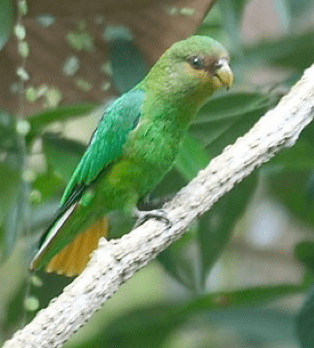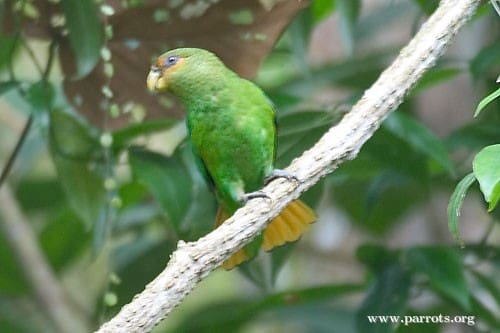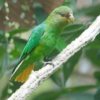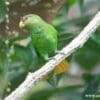DID YOU KNOW?
Parrotlets are the smallest of the New World (South American) parrot species.

Touit

surdus
Size:
16 cm (6.2 in)
Weight:
Likely 60-70 g, as in other Touit sp.
Subspecies including nominate:
two: T.s. surdus, T.s. ruficauda
Colour Adult:
T.s. surdus: Male-thin frontal band and face gold/yellow; hindneck tinged olive; scapulars and upper tertiary feathers olive/brown; dull blue marking on carpal edge; flanks and sides of lower breast green/yellow; underwing coverts green; centre tail feathers green tipped with black, the side tail feathers green/yellow-tipped with black. Beak olive/yellow with grey at base. Eye grey. Female-side tail feathers green/yellow margined and tipped with dull green.
T.s. ruficauda: Both adults side tail feathers brown/yellow; smaller.
Colour Juvenile:
Not recorded.
Call:
Fairly loud and reminiscent of a flock of seagulls.
Content Sources:
CITES
BirdLife International
Cornell Lab of Ornithology/Birds of the World
Parrots: A Guide to Parrots of the World, Juniper and Parr, 1998
Parrots: Status Survey and Conservation Plan 2000-2004, Snyder, McGowan, Gilardi and Grajal, 2000.
Parrots of the World, Forshaw, 2006. 2010 edition
Captive Status:
Not found in captivity.
Longevity:
—
Housing:
—
Diet:
—
Enrichment:
—
Nest Box Size:
—
Clutch Size:
Not recorded.
Fledging Age:
—
Hatch Weight:
—
Peak Weight:
—
Weaning Weight:
—
World Population:
Fewer than 10,000 mature individuals, decreasing.
IUCN Red List Status:
Vulnerable
CITES Listing:
Appendix II
Threat Summary:
Generally rare and may be overlooked due to quiet nature. Likely to have suffered a substantial and continuing decline with steady deforestation of lowland forest outside of protected areas. Trade appears to be minor.
Range:
T.s. surdus: SE Brazil, from southern Bahia and possibly southern Goias, south to Sao Paulo.
T.s. ruficauda: NE Brazil in Paraiba, Pernambuco and Alagoas.
Habitat:
Lives in humid lowland forest but occasionally visits lower montane slopes, secondary forest canopy in otherwise open country, also will visit fruiting trees in cleared areas. Up to 800 m (2624 ft).
Wild Diet:
Diet includes unripe fruits of Sondius lutea and ripe Rapanea schwackeana. Also a myrtaceous tree and an unidentified Lauraceae species.
Ecology and Behaviour:
May be seasonally locally nomadic in response to food availabliity. Seen in pairs or small flocks of up to 15 birds. Stays in upper canopy of forest.
Clutch and Egg Size:
Not recorded.
Breeding Season:
Probably at the start of the rainy season, September-October. Has been seen in arboreal termitarium.
Related Links:
—



